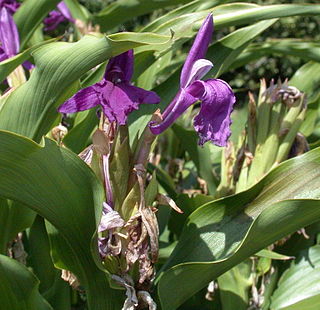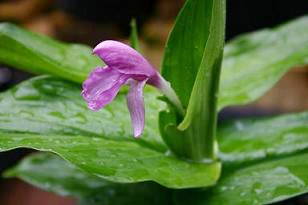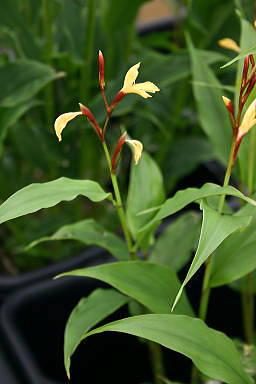
Zingiberaceae or the ginger family is a family of flowering plants made up of about 50 genera with a total of about 1600 known species of aromatic perennial herbs with creeping horizontal or tuberous rhizomes distributed throughout tropical Africa, Asia, and the Americas. Many of the family's species are important ornamental, spice, or medicinal plants. Ornamental genera include the shell gingers (Alpinia), Siam or summer tulip, Globba, ginger lily (Hedychium), Kaempferia, torch-ginger Etlingera elatior, Renealmia, and ginger (Zingiber). Spices include ginger (Zingiber), galangal or Thai ginger, melegueta pepper, myoga, korarima, turmeric (Curcuma), and cardamom.

Roscoea is a genus of perennial plants of the family Zingiberaceae. While most members of the ginger family are tropical, Roscoea species are native to cooler mountainous regions of the Himalayas, China and its southern neighbours. Roscoea flowers superficially resemble orchids, although they are not related. The flowers of Roscoea have a complicated structure, in which some of the showy coloured parts are not formed by petals, but by staminodes, sterile stamens which have evolved to resemble petals. Some species are grown as ornamental plants in gardens.

Cautleya is a small genus of perennial plants of the family Zingiberaceae, found in the eastern Himalayas through to China and Vietnam. It consists of two species of high-altitude tropical and temperate plants, native to cool forest areas – an unusual habitat for members of the Zingiberaceae. They are grown as ornamental flowering plants.

Roscoea auriculata is a perennial herbaceous plant occurring in the eastern Himalayas, in Tibet, Bhutan, Nepal and Sikkim. Most members of the ginger family (Zingiberaceae), to which it belongs, are tropical, but R. auriculata, like other species of Roscoea, grows in much colder mountainous regions. It is sometimes grown as an ornamental plant in gardens.

Roscoea purpurea is a perennial herbaceous plant occurring in the Himalayas, particularly Nepal. Most members of the ginger family (Zingiberaceae), to which it belongs, are tropical, but species of Roscoea grow in much colder mountainous regions. It is sometimes grown as an ornamental plant in gardens.

Roscoea alpina is a perennial herbaceous plant native to the Himalayas. Most members of the ginger family (Zingiberaceae), to which it belongs, are tropical, but R. alpina, like other species of Roscoea, grows in much colder mountainous regions. It is sometimes grown as an ornamental plant in gardens.

Roscoea kunmingensis is a perennial herbaceous plant native to the mountains of China, being found in Yunnan. Most members of the ginger family (Zingiberaceae), to which it belongs, are tropical, but R. kunmingensis, like other species of Roscoea, grows in much colder mountainous regions.

Roscoea tumjensis is a perennial herbaceous plant occurring in the Himalayas, in Nepal. Most members of the ginger family (Zingiberaceae), to which it belongs, are tropical, but R. tumjensis, like other species of Roscoea, grows in much colder mountainous regions.

Roscoea australis is a perennial herbaceous plant found in Burma, to the south of all other members of the genus. Most members of the ginger family (Zingiberaceae), to which it belongs, are tropical, but R. australis, like other species of Roscoea, grows in much colder mountainous regions.
Roscoea brandisii is a species of herbaceous flowering plant in the Zingiberaceae family. It is a perennial found in the state of Meghalaya, India. Most members of the ginger family, to which it belongs, are tropical, but R. brandisii, like other species of Roscoea, grows in much colder mountainous regions.

Roscoea nepalensis is a perennial herbaceous plant found in Nepal. Most members of the ginger family (Zingiberaceae), to which it belongs, are tropical, but R. nepalensis, like other species of Roscoea, grows in much colder mountainous regions.

Roscoea debilis is a perennial herbaceous plant found in Yunnan, China. Most members of the ginger family (Zingiberaceae), to which it belongs, are tropical, but R. debilis, like other species of Roscoea, grows in much colder mountainous regions.

Roscoea schneideriana is a perennial herbaceous plant found in China, in Tibet, Sichuan and Yunnan. Most members of the ginger family (Zingiberaceae), to which it belongs, are tropical, but R. schneideriana, like other species of Roscoea, grows in much colder mountainous regions.

Roscoea scillifolia is a perennial herbaceous plant occurring in Yunnan in China. Most members of the ginger family (Zingiberaceae), to which it belongs, are tropical, but like other species of Roscoea, R. scillifolia grows in much colder mountainous regions. As of 2013, the species is only known in cultivation and may be extinct in the wild.

Cautleya gracilis is a perennial herbaceous plant in the family Zingiberaceae. It is found in the Himalayas through to south China and Vietnam. It is cultivated as an ornamental garden plant, hardy to a few degrees of frost.

Cautleya spicata is a perennial herbaceous plant in the family Zingiberaceae. It is found in the Himalayas through to China (Yunnan). It is cultivated as an ornamental garden plant, hardy to a few degrees of frost.
Curcuma glauca is a species of flowering plant in the ginger family, Zingiberaceae. It is a rhizomatous geophyte endemic to Myanmar. The plant, which is called malaphu (မာလာဖူး) in Burmese, is used as an herb in Burmese cuisine.
Larsenianthus careyanus is a species of the ginger family (Zingiberaceae). It occurs in Bangladesh as well as northeast India. It is the type species of the genus Larsenianthus, which was newly established in 2010.
Larsenianthus assamensis is a species of the genus Larsenianthus in the ginger family (Zingiberaceae). It was first described in 2010 and is native to northeastern India.
Larsenianthus arunachalensis is a species of the genus Larsenianthus in the ginger family (Zingiberaceae).. It was first described in 2010 and is native to northeastern India, and Myanmar.













